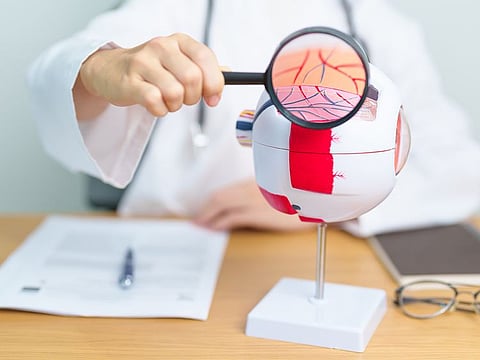Confront your diabetic eye risks
Insights, innovations and care strategies for diabetic retinopathy

If you’re under a doctor’s care for diabetes, you’re likely aware of the risk of diabetic eye disease. The good news is that most diabetic eye diseases can be treated before causing vision loss.
Diabetic retinopathy (DR) is a common and potentially sight-threatening diabetes complication affecting the retina, the light-sensitive tissue at the back of the eye. According to Dr Wissam Charafeddin Aboul-Hosn, Consultant Ophthalmologist at Barraquer Eye Hospital, “DR primarily results from prolonged high blood sugar levels damaging blood vessels in the retina, causing swelling, leakage, and the growth of abnormal blood vessels.”
Dr Aboul-Hosn explains that doctors classify the disease based on findings during an exam, starting with background retinopathy, an early stage with weakened blood vessels. It can progress to macular edema, causing swelling in the central part of the retina, leading to blurred or distorted vision. Proliferative retinopathy is an advanced stage with new abnormal blood vessels on the retina, increasing the risk of bleeding and complications that might lead to vision loss.
Dr Ammar Safar, Chief Medical Officer, Consultant Vitreoretinal Surgeon, and Professor of Ophthalmology (Adjunct) at Moorfields Eye Hospital Dubai, highlights key risk factors for diabetic retinopathy. The longer a person has diabetes, the higher the risk, and poorly controlled blood sugar levels increase the risk.
“To protect their vision, individuals with diabetes should take proactive measures, such as annual or biannual comprehensive eye exams to catch diabetic retinopathy in its early stages,” adds Dr Safar. “Maintaining healthy blood sugar levels, blood pressure, and cholesterol can help reduce the risk and slow the progression of diabetic retinopathy. A healthy diet, regular exercise, and quitting smoking can significantly benefit diabetes management and eye health.”
Latest advancements
Recent years have seen significant advancements in diagnosing and treating diabetic retinopathy (DR), offering hope for improved outcomes. While conventional imaging methods such as macular OCT and fluorescein angiography remain important in diagnosis, new technologies are transforming the landscape of DR management.
AI and machine learning algorithms are now used to analyse retinal images swiftly and accurately in detecting DR. “These automated assessments are especially valuable in areas lacking access to eye care specialists,” says Dr Aboul-Hosn. “Telemedicine allows for remote screening and early detection, while AI algorithms can analyse retinal images, making assessments faster and more accessible.”
Dr Aboul-Hosn further explains that ultra-widefield imaging, a technology providing a broader view of the retina, aids in the comprehensive assessment of DR, including peripheral changes. Additionally, optical coherence tomography angiography (OCTA), a non-invasive imaging technique, is increasingly employed for DR diagnosis. “It offers high-resolution, cross-sectional images of retinal blood vessels without invasive dye injections, enabling a detailed assessment of microvascular changes in the retina,” says Dr Aboul-Hosn.
Dr Safar notes that the UAE has been at the forefront of adopting the latest advancements in diagnosing and treating diabetic retinopathy. Innovative diagnostic tools, such as optical coherence tomography (OCT) and fundus photography, enable healthcare providers to detect retinopathy early.
In terms of treatment, Dr Safar mentions several options available for individuals diagnosed with diabetic retinopathy, depending on the severity of the condition. These treatments include intravitreal injections, anti-VEGF medications that can help reduce abnormal blood vessel growth and improve vision in some cases. “In advanced cases where blood has filled the vitreous gel in the eye, vitrectomy surgery can be performed to remove the blood and scar tissue,” says Dr Safar. “The advancement of this surgical technique has allowed us to save vision and reverse vision loss caused by diabetic retinopathy in most patients who suffer from this disease.”
Dr Aboul-Hosn adds that traditional laser therapy remains effective for treating proliferative retinopathy, while newer techniques like micropulse laser minimise damage to surrounding tissue, crucial when treating the macular region. “Research continues on sustained-release drug implants that can be inserted into the eye, offering long-term medication,” says Dr Aboul-Hosn. “Emerging as a potential treatment, gene therapy uses viral vectors to deliver therapeutic genes to the retina, correcting genetic defects or modulating gene expression. Promising results have been seen in animal models.”
With that said, the best and most effective way to save vision in diabetic retinopathy is to prevent it from happening by having regular checks by your eye doctor, even if you do not have any vision problems yet.
Sign up for the Daily Briefing
Get the latest news and updates straight to your inbox



